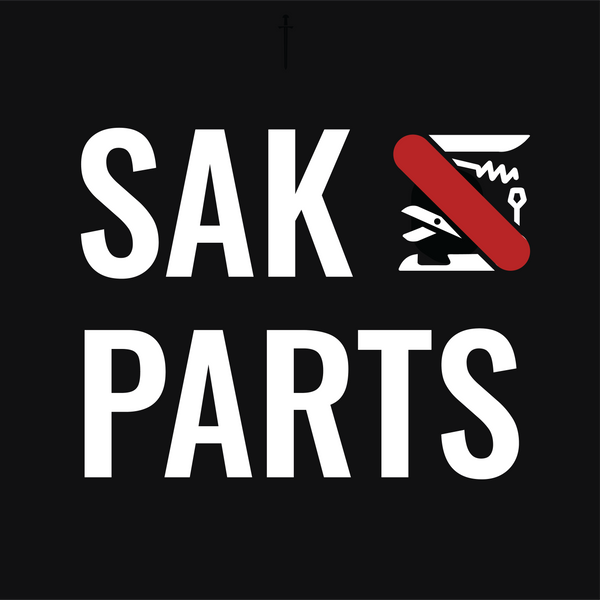✍️ Author: Castor S. Benin, Tactical Gear Contributor
📍Location: Based in Bozeman, Montana
🔗 Series Note: This is the 3rd blog of the Knife blog series. You can check the other blogs I wrote from here – https://sakparts.com/blogs/everything-about-victorinox-swiss-army-knife
What are the Differences Between Victorinox and Wenger Swiss Army Knives? 🧭
If you've ever wondered about the real difference between Victorinox and Wenger multi-tools, you're not alone. Collectors, modders, and everyday carry (EDC) fans often stumble upon both brands, unsure which suits their needs better. In this article, I’ll break down the practical, design, and functional distinctions between these two legendary names — from firsthand experience and hands-on testing.
🔍 A Quick Background
Victorinox and Wenger were the two official suppliers of Switzerland’s military knives for decades. While they shared the same national contract, their products developed distinct identities.
In 2005, Victorinox acquired Wenger, eventually integrating Wenger’s product line under a unified brand by 2013. But the tools from each still carry differences worth noting — especially if you're collecting, restoring, or modifying knives.
📚 Want to dive deeper into the official history? Read more at SAKWiki's comparison article.
⚙️ Design & Tool Differences
🔧 Tool Locking Mechanism
- Wenger introduced a spring-based lock mechanism on some of its larger knives, allowing tools like the blade to lock open for safety.
- Victorinox mostly stuck to slip-joint tools, except in specialized “Lockblade” series.
✅ If you prefer added safety for rugged use, Wenger's locking blades (like those in the Ranger series) might appeal more.
🖐️ Ergonomics & Handling
- Wenger scales are more rounded and contoured for palm comfort.
- Victorinox tools are slimmer, with flatter scales that pack more tools per size class.
🧠 From experience, Wenger models feel more natural in the hand — but Victorinox wins on compact efficiency.
🛠️ Unique Tool Implementations
- Wenger pioneered tools like the folding nail file on smaller models and scissors with a serrated edge and spring integrated into the handle.
- Victorinox stuck to classic spring designs for scissors and more symmetrical toolsets.
➡️ These differences become noticeable when replacing or upgrading parts — see compatible replacements at sakparts.com.
🧲 Spring & Backspring Quality
Both brands used different spring tensions. Wenger’s tools feel “softer” when opening/closing, while Victorinox tools snap firmly with a distinct click.
🛠️ Modding tip: Swapping Wenger parts into Victorinox frames (and vice versa) usually requires adjustment due to spring variance and pin layout.
🪛 Construction and Maintenance Differences
🔩 Assembly Method
- Wenger used a different internal pin layout and backspring configuration — less common in the modding world.
- Victorinox frames are more modder-friendly, with predictable pin sizes and part compatibility.
👉 For this reason, nearly all mod parts sold today (like scales, blades, or tools) cater to Victorinox-style builds. Check SAKParts mod kits for ready-to-use compatible tools.
🧰 Parts Availability and Modding Support
After the Wenger brand consolidation, spare parts for Wenger models became rarer. Most modders, including myself, work primarily with Victorinox-style tools because:
- ⚒️ Part compatibility is better
- 🧩 Accessories (like aftermarket scales) are easier to find
- 🔧 Tutorials and diagrams are more widely available
🔗 Looking for tool or scale replacements? This Wenger vs Victorinox discussion on BladeForums offers community-driven insights from experienced knife techs.
📦 So Which One Is Better?
It depends on what you value:
| Feature | Victorinox-Style | Wenger-Style |
|---|---|---|
| 🔩 Modding/Parts | ✅ Widely supported | ❌ Limited post-2013 |
| 🛠️ Tool Locking | ❌ Mostly non-locking | ✅ Locking blades (select models) |
| 🖐️ Ergonomics | ➖ Slim, flat | ✅ More contoured |
| ⚖️ Tool Density | ✅ High | ➖ Medium |
| 🔧 Spring Feedback | ✅ Crisp and tight | ➖ Softer, smoother |
From a modder’s perspective, Victorinox-style knives are easier to upgrade, maintain, and personalize — which is why modern compatible parts focus on this design.
🔗 Resources to Explore More
-
SAKWiki Victorinox vs Wenger Overview – Technical history and breakdown
-
SAKParts Product Categories – Helpful for identifying compatible mod parts
-
BladeForums Modding Community – Practical, peer-tested advice from real modders
💬 What Do You Think?
If you're a collector or modder, have you worked with both styles before? Let me know your take in the comments. Got a question about compatibility or custom builds? I’m happy to answer directly.
Also, tell me what you'd love to learn next week in the Knife Blog Series

